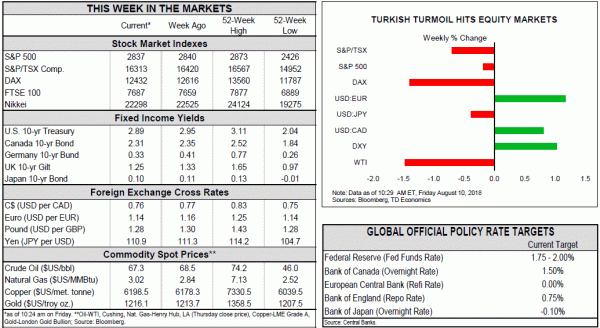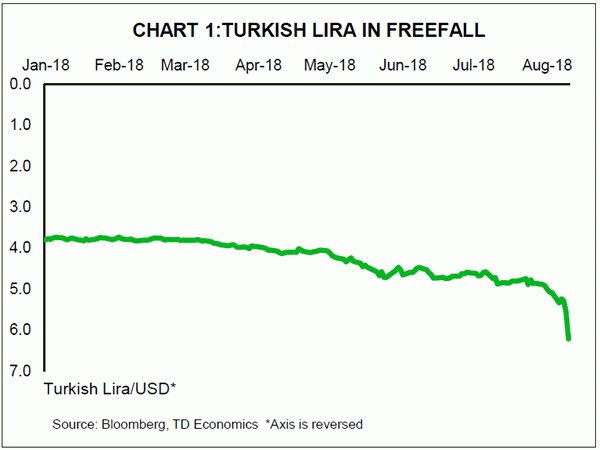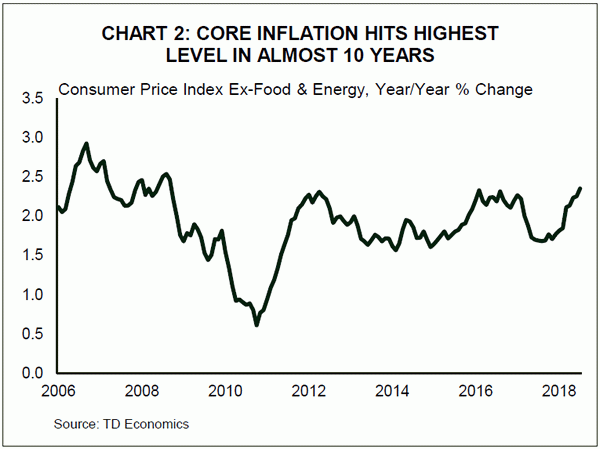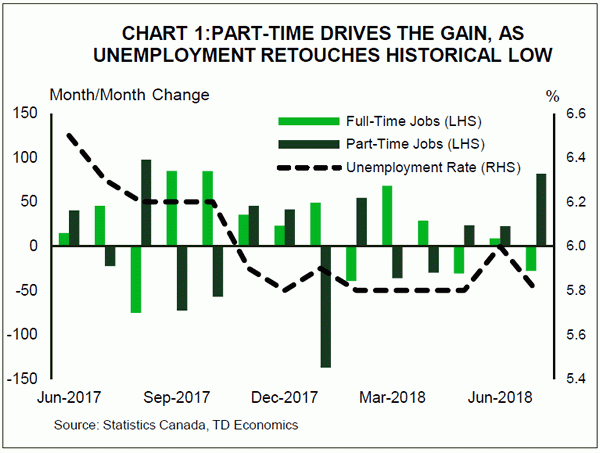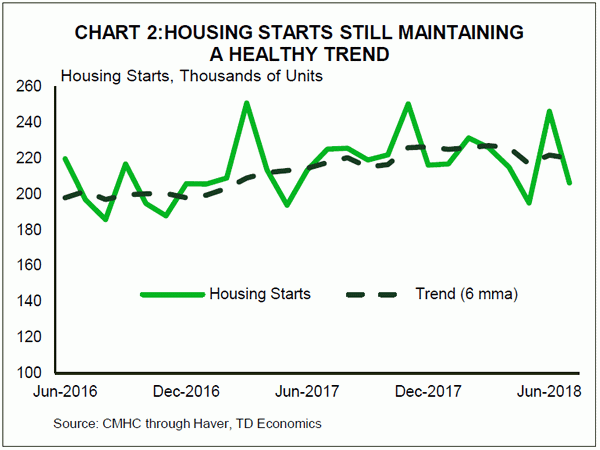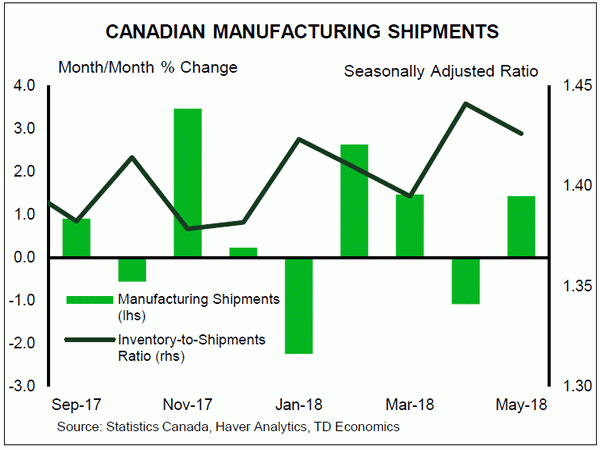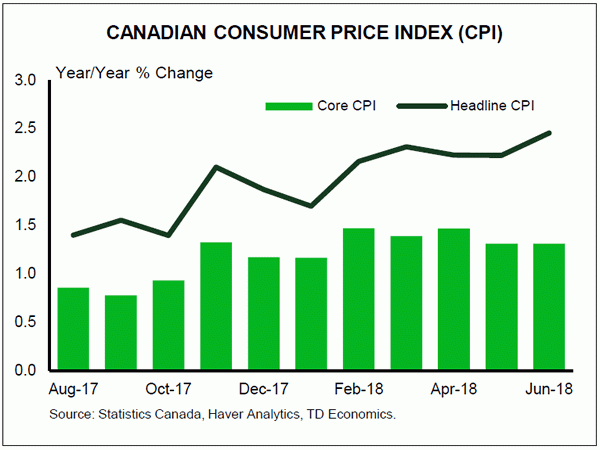U.S. Highlights
- Global equity markets were hit Friday by fears that Turkey’s deepening economic crisis will spread. The Turkish lira plummeted as investors have lost confidence that the Erdogan regime will be able to steer Turkey through its current crisis.
- Meanwhile, U.S. inflation continued its gradual rise in July. Notably core CPI inflation reached a new cycle high of 2.4%.
- Economic conditions in the U.S. argue for a rate hike in September, and Turkey-related turmoil seems unlikely to derail that.
Canadian Highlights
- This week’s jobs report delivered a mixed message, with rosy, above-expectation gains in the headline print, accompanied by declines in full-time work.
- Housing starts came in below expectations, falling to 206k in July, but maintaining a healthy underlying trend
- A Canada-Saudi Arabia diplomatic spat briefly caught the attention of the markets in an otherwise quiet week.
U.S. – Turkish Lira Rout Hits Markets
Global equity markets were hit Friday by fears that Turkey’s deepening economic crisis will spread. The Turkish lira fell 16% (Chart 1) as investors have lost what little confidence they had that the Erdogan regime will be able to steer Turkey through its current crisis. Turkey has substantial foreign-currency-denominated debts, and low foreign currency reserves – a classic recipe for speculative attack. Worries intensified as tensions between Turkey and the White House run high. As Turkey’s finance minister was giving a speech, President Trump tweeted that he plans to double steel and aluminum tariffs on the country.
The key worry is the degree of contagion to other countries. Turkey has significant trade and banking ties with Europe, but not sufficient to fuel a contagion effect. Still, the lira rout has hit European bank shares with exposure to the country, and banking authorities are on high alert.
For the U.S. economy, attention was focused on consumers and producer prices for July. Overall, the story is that inflation continues its gradual march upwards. Core consumer price inflation hit a new cyclical high in July, up 2.4% year/year (Chart 2). Price pressures picked up for both core goods (+0.1% m/m) and core services (+0.3% m/m). A 25% tariff on $34 bn worth of Chinese imports came into effect early in the month, and so the data was closely watched for early tariff impacts, which would most likely show up in prices for core goods. Deflation in core goods at the consumer level has been waning for some time, and growth is now flat on a year-on-year basis. At the producer level, inflation has been much higher for a while now. While companies can absorb some of this in their margins, we do expect price increases to increasingly be passed on to the consumer, boosting inflation.
The Fed’s task will be to disentangle how much of this is thanks to tariffs, and how much is due to a hot economy. In the July PPI, prices were up for categories that likely contain products from China subject to new import tariffs, so we are likely already seeing some impact. But these prices have been rising for some months, suggesting an upward trend was in place pre-tariffs.
At the end of the day, services prices carry a far greater weight in the CPI (62%), and inflation for core services has been building steadily. Shelter costs have been particularly hot, up 3.5% year/year in July, and carry a heavy weight in the CPI basket (about 1/3 of the total). Inflation pressures have been strong for both rent (+3.6% y/y) and owners’ equivalent rent (+3.4% y/y). Transportation services inflation has also been hot, up 4% year/year. Even services categories with below average inflation have seen momentum building in recent months.
These price pressures justify FOMC rate increases in the months ahead. So far, Turkey-related market volatility seems unlikely to delay a September hike. Looking into 2019, however, if we don’t start to see some move upward in longer-term yields, Fed hikes may be jeopardy, given the Fed’s desire not to cause an inversion of the yield curve.
Canada – Another Rate Hike on the Way
Following last week’s blockbuster GDP and trade surprises, this week’s economic data releases had a high bar to jump over to maintain momentum. The data this week, while mixed, did little to change the story of a healthy economy operating near full capacity. As we discuss in the latest Dollars and Sense, with continued strong economic performance, the pieces are in place for the Bank of Canada to raise the overnight rate in October.
Today’s jobs report is relatively immaterial on a standalone basis (given the usual noise), but still adds some credence to existing optimism, showing solid employment gains and painting a healthy picture of the labour force. The economy added 54k jobs in July, with the unemployment rate falling to 5.8% – a very healthy number relative to historical standards.
One area of concern is the quality of job gains, where the headline gain was driven mostly by part-time hiring (+82k), leaving full-time employment down 28k jobs on the month. While wages posted increases, growth decelerated relative to prior months, which may be attributable to the part-time nature of the jobs gained. Additionally, the job gains were relatively concentrated, with public sector hiring driving most of the gains. Nevertheless, we would chalk most of this up to monthly noise. On a yearly basis, full-time jobs still make up the majority of job gains, solidifying the overall healthy labour market picture.
Housing starts, meanwhile, fell to 206k units (annualized) from last month’s notable 246k pace. This decline was led by the multifamily category, particularly in Toronto and Montreal, which surged in the prior month. Given the volatile nature of the monthly series, the underlying trend (6-month moving average), at 220k, offers a clearer picture of what is still a healthy market, still trending above demographic fundamentals.
With continued monetary policy tightening on the horizon and increased macroprudential regulations, the expectation is that housing will continue to slow, albeit gradually. Price pressures are also starting to manifest, with Statistics Canada citing the impact of rising lumber prices on its New Housing Price Index (NHPI) measure, which moved up 0.1% on the month in June. Together with steel and aluminum tariffs, these may add some pressure on construction costs, but given solid permit issuance and an otherwise healthy economy, the impact should be limited.
Aside from data releases, the relatively quiet week for financial markets was interrupted by the escalation of a Canadian-Saudi diplomatic spat that started over the weekend. Markets initially reacted negatively, with the S&P/TSX and the Canadian dollar falling slightly, but reversing those losses thereafter and returning to positive territory. The impact of the fallout isn’t expected to be large given the relatively insignificant size of trade between the two countries, and the reassurance of continued oil shipments.
Canada: Upcoming Key Economic Releases
Canadian Manufacturing Sales – June
Release Date: August 16, 2018
Previous: 1.4%
TD Forecast: 1.1%
Consensus: 1.1%
TD looks for manufacturing sales to post a 1.1% m/m increase in June on a rebound in auto production after supply chain disruptions weighed on the prior month. Primary metals will provide a modest offset on recently imposed steel and aluminum tariffs, which saw exports fall by roughly $200m (nsa) in June, while nondurables should be led by strong petroleum sales as presaged by a rebound in exports. Elsewhere, business surveys continue to indicate robust manufacturing conditions with Markit PMI posting a new record high in June. However, rising factory prices will see real manufacturing sales post a more modest advance of roughly 0.5% m/m.
Canadian Consumer Price Index – July
Release Date: August 17, 2018
Previous: 0.1% m/m, 2.5% y/y
TD Forecast: 0.0% m/m nsa, 2.5% y/y, Index: 133.6
Consensus: 0.0% m/m nsa, 2.5% y/y, Index: 133.6
We expect headline CPI to hold at 2.5% y/y in July, with prices flat on the month (0.3% seasonally adjusted). Gasoline prices rose on the month while warmer than normal temperatures suggest energy services could see a boost as well. Currency depreciation (-3% cumulative since April) along with tariffs imposed on the US on July 1 suggest firmer price pressures for categories such as food at home, appliances and personal care products. The tariffs, however, impact just 3% of merchandise imports, and we expect impacts to feed through at a lag. We expect to see the gap between exclusion-based core indexes (CPIX and CPIXFE) and BoC core measures to narrow with this report, with the latter staying near 2.0% on average and the former moving marginally higher. Looking ahead, July CPI likely marks the peak this year, as we continue to expect a moderation toward 2% through year end.




